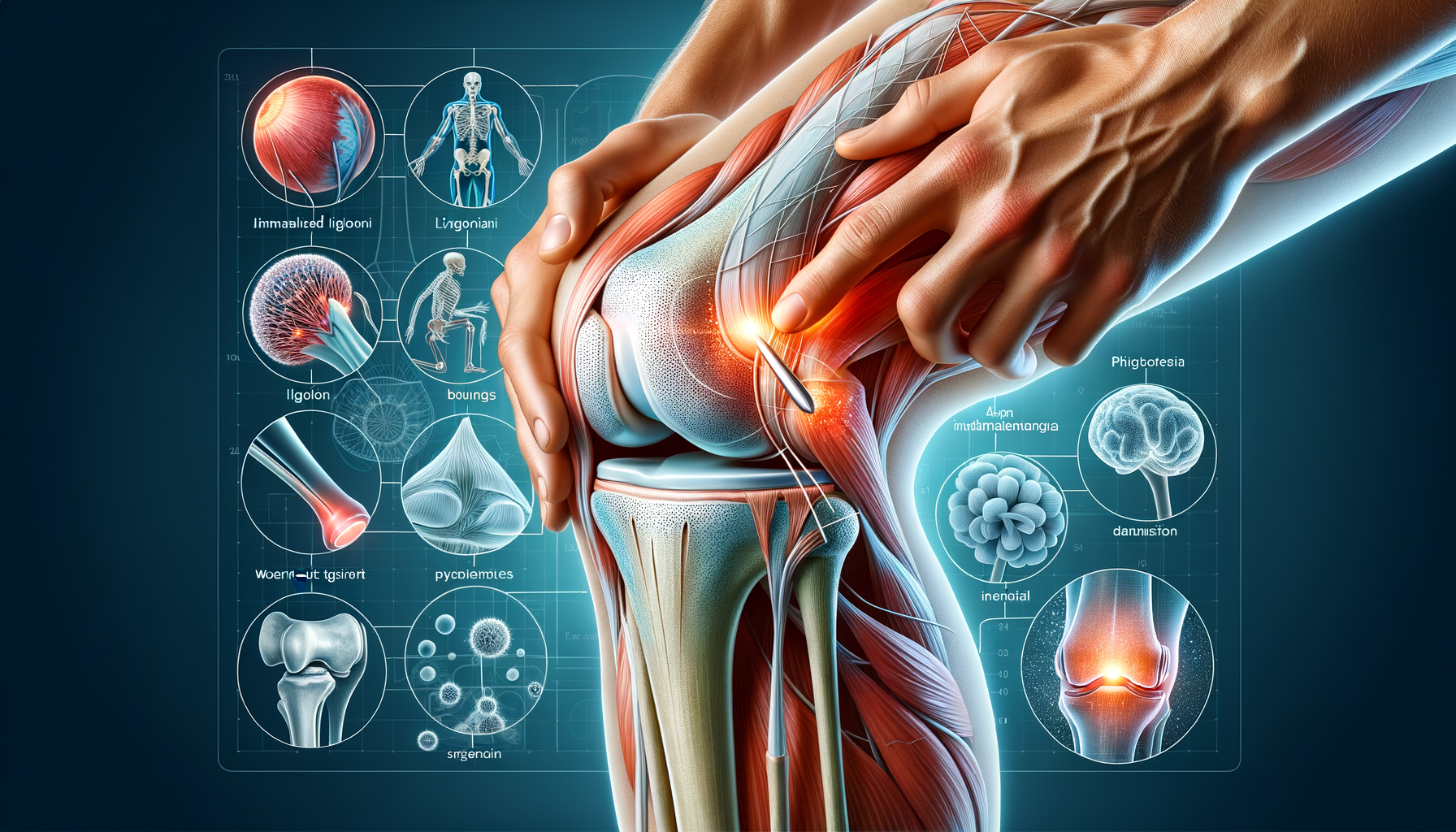Introduction to Knee Pain
The human knee is a marvel of engineering, a complex joint that bears the brunt of our body’s weight and allows for a wide range of motion. However, this complexity also makes it susceptible to a variety of ailments. Knee pain is a common complaint that affects people of all ages, and it can stem from a variety of causes. Understanding these causes is crucial for effective treatment and management.
Knee pain can be caused by injuries, mechanical problems, types of arthritis, and other problems. Injuries such as torn ligaments or cartilage can lead to significant pain and discomfort. Mechanical issues, like a dislocated kneecap or hip or foot pain, can also contribute to knee pain. Furthermore, conditions like arthritis, including osteoarthritis and rheumatoid arthritis, are common culprits of knee pain, particularly in older adults.
The importance of addressing knee pain cannot be overstated. It can significantly impact one’s quality of life, limiting mobility and leading to a sedentary lifestyle, which can exacerbate other health issues. Therefore, understanding the underlying causes of knee pain and exploring effective treatments is essential for maintaining a healthy and active lifestyle.
Common Causes of Knee Pain
Identifying the root cause of knee pain is the first step toward effective treatment. Various factors can contribute to knee pain, and they often overlap, making diagnosis a complex process.
One of the most prevalent causes of knee pain is injury. Sports-related injuries, such as anterior cruciate ligament (ACL) tears, are common among athletes. These injuries can occur during activities that involve sudden stops, jumps, or changes in direction. Meniscus tears, often resulting from twisting motions, are another frequent source of knee pain.
Arthritis is another significant contributor to knee pain. Osteoarthritis, the most common form of arthritis, results from the wear and tear of cartilage, leading to pain and stiffness. Rheumatoid arthritis, an autoimmune disorder, can also affect the knees, causing inflammation and damage to the joint.
Mechanical problems, such as a dislocated kneecap or foot issues, can also lead to knee pain. These problems can alter the alignment of the knee joint, resulting in pain and discomfort. Additionally, conditions like iliotibial band syndrome, which occurs when the ligament running from the hip to the knee becomes tight, can cause pain on the outer side of the knee.
Non-Surgical Treatments for Knee Pain
For many individuals, non-surgical treatments can effectively manage knee pain and improve function. These treatments often focus on reducing inflammation, alleviating pain, and strengthening the muscles around the knee.
Physical therapy is a cornerstone of non-surgical treatment for knee pain. A physical therapist can design a tailored exercise program to strengthen the muscles around the knee, improve flexibility, and enhance overall joint function. Exercises such as quadriceps strengthening, hamstring stretches, and low-impact aerobic activities are commonly recommended.
Medications can also play a role in managing knee pain. Over-the-counter pain relievers, such as nonsteroidal anti-inflammatory drugs (NSAIDs), can help reduce pain and inflammation. In some cases, prescription medications or topical creams may be recommended for more severe pain.
Additionally, lifestyle modifications can significantly impact knee pain management. Weight loss, for example, can reduce the stress on the knee joint, alleviating pain and slowing the progression of arthritis. Using supportive devices, such as knee braces or orthotic inserts, can also help stabilize the knee and reduce pain during daily activities.
Surgical Options for Knee Pain
When non-surgical treatments fail to provide relief, surgical interventions may be considered. Surgery is typically reserved for cases where knee pain is severe, persistent, and significantly impacts quality of life.
Arthroscopic surgery is a minimally invasive procedure often used to repair knee injuries. During this procedure, a surgeon inserts a tiny camera into the knee joint, allowing for the repair or removal of damaged tissues. This type of surgery is commonly used to address issues such as torn meniscus or ligament injuries.
In more severe cases, partial or total knee replacement surgery may be necessary. This involves replacing the damaged parts of the knee with artificial components. Knee replacement surgery is usually considered for individuals with advanced arthritis who have not responded to other treatments.
While surgery can be effective, it is not without risks. Potential complications include infection, blood clots, and issues with the artificial joint. Therefore, it is essential to weigh the benefits and risks of surgery and discuss them thoroughly with a healthcare provider.
Conclusion: Navigating Knee Pain
Knee pain is a multifaceted issue that requires a comprehensive approach to treatment. Understanding the underlying causes and exploring a range of treatment options can help individuals manage their pain effectively and maintain an active lifestyle.
Whether through non-surgical methods like physical therapy and lifestyle modifications or surgical interventions, the goal is to reduce pain, improve function, and enhance quality of life. It is essential for individuals experiencing knee pain to consult with healthcare professionals to determine the most appropriate treatment plan tailored to their specific needs.
By taking proactive steps and seeking appropriate treatment, individuals can navigate the challenges of knee pain and continue to engage in the activities they enjoy.




Leave a Reply